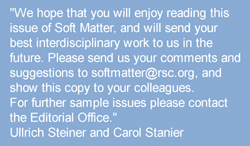Soft Matter—crossing the boundaries of physics, chemistry, and biology
Abstract
Ullrich Steiner and Carol Stanier welcome you to the first issue of Soft Matter, a new journal providing a forum for the communication of fundamental science underpinning the properties and applications of soft matter.
You may consider yourself to be a chemist, physicist, materials scientist, an engineer, or a biological scientist, but much of the work you do is at least as relevant to these other disciplines as to your own. While there are presently a number of journals dedicated to the various fields of macromolecular science, materials science and organic materials in general, these journals are often associated with the traditional disciplines. In the field of soft matter, these borders are fading. The purpose of this new journal is to provide an interdisciplinary platform for the exchange of information and discussion across the traditional disciplines, with strong focus on soft materials. Soft Matter is the only journal for the many interdisciplinary soft matter communities.
International influence
Our enthusiastic and supportive Editorial Board members come from around the globe and have contributed greatly to the launch of Soft Matter, for which we thank them all. You can read about them in the Editorial Board Profile in this issue. Their research interests and backgrounds range over physics, chemistry and biology, materials science, and chemical engineering; most of them are working right on the borderlines of these disciplines—their interdisciplinary knowledge will be invaluable in providing direction for this pioneering new journal, and will ensure that it reflects the needs and views of the community.Varied content
The broad scope of Soft Matter includes bulk soft matter assemblies, soft nanotechnology and self-assembly, biological aspects of soft matter, surfaces, interfaces, and interactions, building blocks/synthetic methodology, theory, modelling, and simulation of soft matter. This is reflected in the papers in this issue, which range from the switching of polymer brushes from soft to “hard” matter (Fig. 1),1 modelling of the flow of complex fluids in channels (Fig. 2),2 the use of gels in art conservation (Fig. 3),3 and the use of microfluidic devices to formulate double emulsions (Fig. 4).4 Nobel laureate Pierre-Gilles de Gennes also adds words of support for our aims in his Comment.5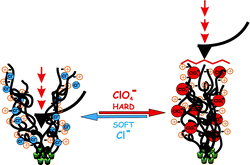 | ||
| Fig. 1 AFM study of cationically charged polymer brushes: switching between soft and hard matter by Huck et al.1 | ||
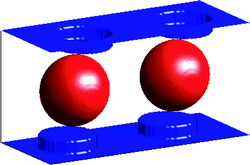 | ||
| Fig. 2 Modeling the flow of complex fluids through heterogeneous channels by Balazs et al.2 | ||
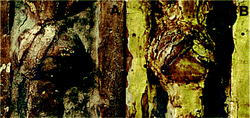 | ||
| Fig. 3 Soft matter and art conservation. Rheoreversible gels and beyond by Weiss et al.3 | ||
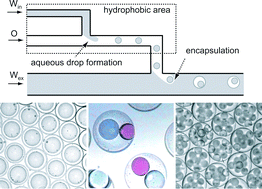 | ||
| Fig. 4 Controlled formulation of monodisperse double emulsions in a multiple-phase microfluidic system by Nisisako et al.4 | ||
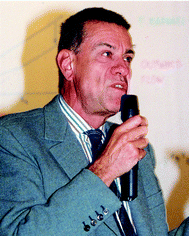 | ||
| Plate1 Pierre-Gilles de Gennes | ||
The variety is continued in all the different paper types that Soft Matter will publish:
• Communications and Full Papers—the latest original results
• Reviews—critical overviews of a topical and significant area of research
• Emerging Areas—short, personal accounts
• Highlights—updates of important new developments
• Opinions—personal viewpoints
This variety of formats is designed to give scientists from all disciplines the chance to discuss matters relevant to their research, to convey new ideas and to revise their opinions of existing concepts.
Accessible and visible
Soft Matter is available to a large and varied readership. It will be published monthly in print and online in Journal of Materials Chemistry and there is free online access for subscribers to Physical Chemistry Chemical Physics (PCCP), Organic & Biomolecular Chemistry, and Lab on a Chip. This ensures that the excellent work that you send to us reaches as wide an audience as possible.Fast service
Fast publishing is a trademark of RSC journals and typical publication times are 60 days for Communications and 90 days for Full Papers from receipt to publication as Advance Articles on the web. Advance Articles typically appear 30–40 days before their publication in print so visit www.softmatter.org today to view the latest content and find out more. While you are there, sign up for our electronic contents alerts which will keep you informed when each new issue is published. Look out for Issue 2 of Soft Matter, which will be appearing in print and online in July.All authors will benefit from the first class professional service for which the RSC is renowned. Free colour is also available to authors where it is scientifically necessary.
Submit online
You can submit your high quality work, supply referee comments, and track the progress of your manuscript online at www.rsc.org/ReSourCe. Particular thanks must go to all those top scientists who have refereed work in this issue as their comments have helped shape the high quality content.We welcome submissions from North America and Canada, and these authors may choose to submit their work to our Associate Editor in this area, Professor Darrin Pochan. Darrin will not only handle manuscripts throughout the editorial process, but will represent Soft Matter at conferences and act as a link between the Cambridge, UK, office and his area. He is already active in promoting Soft Matter, and is happy to answer any questions you may have. This is a very important role and we are very grateful for his support.
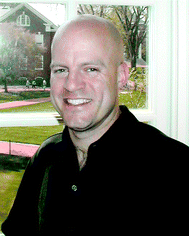 | ||
| Plate2 Professor Darrin Pochan welcomes submissions from the whole of North America and Canada | ||
Serving the community
Soft Matter comes from the strong background of publishing at the RSC, a not-for-profit organisation dedicated to serving the worldwide scientific community and disseminating knowledge.We aim to unite the disperse communities involved in soft matter in one journal, something that has not been achieved to date by any other journal. By bringing together scientists of different disciplines, we hope not only to promote communication and debate between the different factions but to see further growth of the area as a whole. Soft Matter is the future home of soft matter research.
Professor Ullrich Steiner
Chair of the Soft Matter Editorial Board
Dr Carol Stanier
Editor of Soft Matter
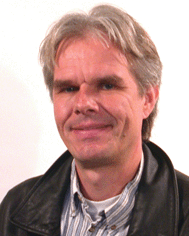 | ||
| Plate3 Professor Ullrich Steiner, Chair of the Soft Matter Editorial Board | ||
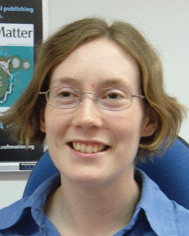 | ||
| Plate4 Dr Carol Stanier, Editor of Soft Matter | ||
References
- T. Farhan, O. Azzaroni and W. T. S. Huck, Soft Matter, 2005 10.1039/b502421h.
- A. C. Balazs, R. Verberg, C. M. Pooley and O. Kuksenok, Soft Matter, 2005 10.1039/b500866b.
- E. Carretti, L. Dei and R. G. Weiss, Soft Matter, 2005 10.1039/b501033k.
- T. Nisisako, S. Okushima and T. Torii, Soft Matter, 2005 10.1039/b501972a.
- P.-G. de Gennes, Soft Matter, 2005 10.1039/b419223k.
| This journal is © The Royal Society of Chemistry 2005 |

